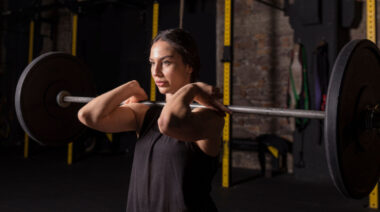The bottoms-up kettlebell press is a great drill to build shoulder strength and mobility. The challenge of keeping the kettlebell upside down teaches you how to tighten the core and find your groove in the press. In this article, I’ll take you through the benefits and explain how to do bottoms-up kettlebell presses.
According to the Internet, the bottoms-up kettlebell press came from Pavel Tsatsouline:
“The bottom-up press came to fruition after Pavel couldn’t reach the fire alarm. A 48 kilo was hanging around.” I am not sure how true that statement is, but Pavel has mentioned the bottoms-up press in Enter the Kettlebell.
At first glance, it might seem like a simple trick or a way to show off, but it has many benefits that push it into my movement repertoire.
Before you press, think of engaging your lats like you would on the eccentric portion of a pull up.
Benefits of the Bottoms-Up Press
One of the biggest benefits of the bottoms-up press is that it teaches you the principle of irradiation. As you grip the bell tightly, the rest of your arm tenses.
The tension in your arm irradiates to create more stability in your shoulder. Similarly, as you tense your torso, the irradiation principle increases strength in your shoulder.
Here are some other key benefits of the bottoms-up press:
- Trains the Press: It helps you find the right groove for presses. Your shoulder will find the path of least resistance and most stability to press the weight.
- Teaches Core Stability: Your thighs, glutes, abs, and lats must all be kept tight to build a solid foundation for the shoulder to press the kettlebell. If you are loose like a noodle below the press, it will be much more difficult to press the weight.
- Relieves Achy Elbows and Shoulders: With the weight upside down, you will feel the pressure in your palm. This tends to keep the elbows in a great position. Bottoms-up presses are also an effective (but complicated) rehab tool, as they build rotator cuff strength.
Holding the kettlebell upside down is quite challenging. It will want to sway and tip back into place. In order to keep it upside down, your grip, shoulder stability, and core tightness must all work together.
You must have good grip strength as your shoulder moves through its range of motion. In addition to all of the above components, you also need thoracic mobility and rotator cuff strength to find the right pressing groove.
Progressions to Build Your Pressing Capacity
- The Clean: An important piece of the clean is how you grip the kettlebell on the ground. You can imagine doing a push up or handstand on the kettlebells. This trigger will allow you to get the meaty part of your palm solidly against the kettlebell. From that position, you will grip the kettlebell tightly and clean it into position. If it is your first time, I would recommend “cheat” cleaning it into position by using your other arm to guide it into place. In the rack position, you will want to have your arm connected to your lat. You can gain much more stability by having your upper arm rest tightly against the body. Tightening your thighs, glutes, and abs also increases the tension and keeps the kettlebell in place.
- Rack Carries: Once you have learned stability in the rack, it is useful to create a bit more instability by walking. I alternate farmer’s carries, overhead carries, and bottoms-up carries.
- Bottoms-Up Presses: Once you have learned to keep the kettlebell stable, you can then attempt to press it overhead. I recommend that you keep your free hand near your face to protect yourself if the kettlebell flips over. Although it might seem counterintuitive, you will benefit from engaging the lat by pulling it back and down. This helps stabilize the shoulder and builds strength.
Train Your Most Stable Path
I have heard people who have sore elbows or shoulders say that bottoms-up kettlebell presses have given them a great alternative for presses.
Bottoms-up presses teach the body how to stabilize and force the shoulder to find the most stable pathway. These benefits can greatly help your other presses.
It might take a few practice sessions until you are able to do a bottoms-up press. Don’t give up if you can’t do it right away. Once you get the hang of it, I imagine you will add this lift to your library of movements.
You’ll Also Enjoy:
- 3 Mobility Drills for Solid Overhead Lifts
- Train Your Body to Love Holding Heavy Weights Overhead
- 4 Drills That Will Improve Your Kettlebell Press
Photo courtesy of Craig Marker.






